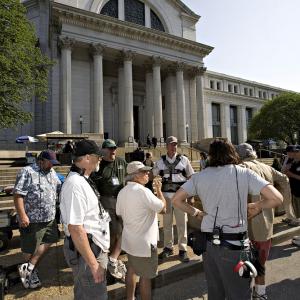How is the Smithsonian, with its museums full of specimens and research labs full of scientists, portrayed in movies, novels, television, and videogames? Smithsonian staff and the iconic buildings they work in have been portrayed in mysteries, romances, dramas, comedies, and science fiction. Often, the ways that museum curators, explorers, and lab researchers and what they do are represented very differently from how Smithsonian staff think about themselves. How do these portrayals of the Smithsonian help us understand how the public perceives our work and what goes on behind the scenes? Are the Smithsonian’s back halls really populated by mad scientists and obsessive collectors? Did the curator really do it in the library with the candlestick? How have these perspectives changed over time?
The Smithsonian, perhaps more than any other museum or research complex, has been the setting for fiction writing ranging from work by Gore Vidal to the TV series Bones to films including Night at the Museum. In all of those depictions, subtle differences emerge in the portrayal of science, art, anthropology, and history. Anthropology has been perhaps the most popular topic for fiction writers. By looking at movies, television, novels, and videogames and asking the question, “Did the curator really do it?,” we’ll see how popular fiction writers construct the characters of museum workers and research scientists and what they think of the Smithsonian’s world.
This website will introduce you to the Smithsonian in popular culture. We’d also like to hear from you about your favorite novels, films, games, or television programs. Got an example of the Smithsonian in popular culture that you love? Let us know!




